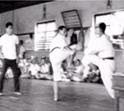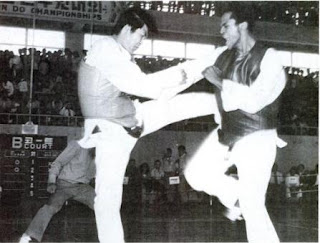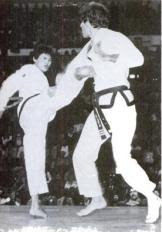Brief history of Taekwondo :
From the Western Middle Ages time, fighting techniques with bare hands have been developed in Korea. The contributions of Kung-Fu and Karate neighbours are undeniable, given the proximity of China and the invasion by Japan, in the twentieth century.
Released in 1945, Korea was divided into two parts. Traditional martial arts were still alive and not unified. Korean War took place from 1950 to 1953, with a strong U.S. intervention.
Choi Hong Hi :
General Choi is a karate black belt, after a period of his life in Japan, before World War II. At the end of this war, he returns to South Korea and becomes a soldier.
In 1955, Choi Hong Hi, a Chung Do Kwan practitioner, proposes the name of Taekwondo (the kicks and punches way), to several teachers, gathered together to unify the various existing schools (Kwan). The Korean Taekwondo Association is created in 1959 to facilitate the unification. The role played by various military officers during this unification has something to do with the teaching of Taekwondo in the army.
General Choi creates the ITF (International Taekwondo Federation) in 1966. He is forced to leave South Korea in 1971. General Choi wanted to teach Taekwondo in North Korea, but the South refused this project. ITF then moves its headquarters out of South Korea, in Toronto/Canada.

Un Yong Kim :
Un Yong Kim, former Secretary to the Prime Minister , diplomat and former head of presidential protection forces, is elected president of the Korean Taekwondo Association in 1971. He participates in the building of the Kukkiwon, the World Taekwondo centre. He becomes the WTF president in 1973, at its foundation.
Un Yong Kim is Vice-President of the Organizing Committee for the Seoul Olympics Games in 1988. Taekwondo is introduced during these Games, as a demonstration sport.
He joins the IOC in 1986 and becomes its Vice-President in 1992.
He retires from the WTF in 2004 and from the IOC in 2005, following several cases of corruption. One of this case concerns the determination of the Olympic cities and other concern sport corruption in Korea. Un Yong Kim is ultimately sentenced to 2 years in jail.
Tang Soo Do :
In the United States, the term Tang Soo Do is frequently used during the 60s and 70s. It is very difficult to make a history of this art, which emerge from one of the Kwan above mentioned, the Moo Duk Kwan. This branch has refused the Taekwondo unification. Thereafter, the Tang Soo Do has been divided into various families. The Tang Soo Do techniques have been very influenced by Japanese karate. Tang So Do means "The way of Chinese hand", as the japanese term "Karate Do".
USA :
The presence of U.S. troops in Korea, following the military intervention during Korean war, has allowed many GI to learn Taekwondo and to import this Martial Art in the USA. At the same time, Taekwondo (or the South Korean government) will send Korean instructors, all over the world, to teach their sport.
For example, Jack Hwang practices Taekwondo since his early childhood. After a time in the Korean army, Hwang arrives in 1957 in the USA and teaches martial arts. He has, among others, Mike Stone as a student. Hwang is a Taekwondo (then named Karate) precursor in the U.S. South-West.

Allen Steen takes over Jhoon Rhee's school, after the latter's departure to Washington. Steen is considered as the father of karate in Texas. Pat Burleson, already practicing Karate, becomes one of his students.
Allen Steen creates the Texas Karate Institute in 1962, with Richard Jenkins. This 'Made in Texas" Karate, Taekwondo in reality, is known to be tough and with high level of contact.
Steen creates the Southwest Karate Black Belt Association in 1964 in Dallas/Texas. It becomes the American Black Belt Karate Association in 1972 and adds to it the name "Chin Sook Hage Kwan" in 1981. Skipper Mullins and Roy Kurban are his students.
Henry Cho, from Korea, arrives in the USA. in 1958. He teaches Taekwondo in this country, creating many schools all around the country. Henry Cho also organizes the All American Open Tournament of Champions, which includes Taekwondo and Karate.
Byong Yu is an interesting character of this period. This Korean arrives in the USA in 1964. He takes part in many American tournaments, against various bigger and heavier opponents.
Various American Taekwondo fighters :
Chuck Norris (see his article in this blog) is a perfect example of the karate fighter, who was practicing Tang So Doo. He was in the army, in Korea, in 1958.
In 1966, Norris takes part to the Tang Soo Do Invitational Tournament, held in Washington/DC. He loses against John Camanse, in the prelims, in the middleweights division.
In 1967, Norris wins the American Tang Soo Do Championships. It proves that separate competitions existed in the U.S. for Korean Martial Arts practitioners. He defeats Skipper Mullins for the Grand Champion finals. Shorin-Ryu and Burmese Bando Fighters also take part in these championships (Black Belt March 1968).
Chuck Norris wears often a white uniform lined with black, typical of Taekwondo (Dobok).

In 1968, in Sacramento/California, a tournament takes place between a Korea team and the USA. Joe Lewis and Ron Marchini are part of the American team. Lewis def Ju Kim Hum, after a violent and unfair fight. Marchini also meets Ju Hum Kim and also wins after a bloody match for Marchini's face. Lewis vs Byung (Byong) Yu, Captain of the Korean team, is violent and Lewis appears to have won. The U.S. wins by 8 victories to 7 defeats (Black Belt November 1968).
Jeff Smith (see his article in this blog) is also a Taekwondo practitioner and a former Jhoon Rhee and Allen Steen's student.
Mitchell Bobrow receives his black belt from Ki Whang Kim in 1965. Bobrow is often mentioned as one of the best karate fighters and is member of the U.S. team during the 1st WUKO World Championships Karate in 1970, in Tokyo. In 1968, in Philadelphia, Bobrow, 17 years old, beats Joe Lewis, at the Tae Gyun Tourney. Joe Lewis was the winner at the end of the fight, but an overtime has been decided, during which Mitchell Bobrow beats his opponent. Bobrow loses in the finals to Dutcher (Black Belt January 1969).
In the 70s, the AAU National Taekwondo Association already exists. The United States Taekwondo Union (USTU) will absorb it, and will become the USA Taekwondo (USAT), linked to the WTF. Henry Cho is one of the members of this association.
WTF World Championships :
The Taekwondo needs to grow and to gain world recognition. To do this, the WTF, newly formed, organizes the World Championships, three years after the WUKO had done the same thing for karate.
May 25 to 27, 1973. Seoul/South Korea.
This paragraph is based on the November 1973 Black Belt magazine.
17 nations take part in this first World Championship, in the Kukkiwon. Fighters wear already a blue or red plastron, without other protection. The punches to the face are forbidden, but the kicks are allowed.
The U.S. Central and West Team are quickly eliminated, the latter vs Mexico.
The U.S. East Team loses his first match against Korea, by 2 to 0. U.S. beats after West Germany and Taiwan, by 3 to 2. In the finals, South Korea wins against the USA East Team, by 3.5 to 1.5. Taiwan finishes 3rd and Mexico 4th.
Team U.S. East Team is composed of Mike Warren, Archie Cole, Joseph Hayes, Albert Cheeks, Jim Butin, and coach Jack Hwang or David Kim ?, depending on the versions.


In the heavyweights, Mike Warren loses against Jung Tae Kim in the finals. Albert Almond Cheeks finishes 3rd and Raymond B. Sell 4th.
In the lightweights, Joe Hayes finishes 3rd, beyind Ki-Hyung Lee (Kee-Hyung Lee) and Charero/West Germany ?, and Georg Karrenberg (West-Germany) 4th.

Un Yong Kim gives the team medal
 Mike Warren, right, face Uee-Sung Kawg, during the team finals.
Mike Warren, right, face Uee-Sung Kawg, during the team finals.
August, 28 to 31, 1975. Seoul / South Korea.
During the second World Championships, 30 nations are represented. South Korea Team wins the competition, Taiwan is 2nd and Mexico 3rd. The U.S. team is composed by William Felton, Gerard Robbins, Dennis Robinson, Terrance Watson, Frank Rodriguez, Gary Mule, Clark Murphy, Robert Philips and John Holloway.

Program of the second World Championships
In the individuals, are 8 weight divisions. Only Dennis Robinson wins a medal, a bronze in the bantams. The South Koreans wins 8 gold medals.
ITF World Championships :
Like the karate IAKF Federation, the second World Taekwondo Federation, ITF, organizes its own World Championships.
October 4 to 5, 1974. Montreal / Canada.
This paragraph comes from the February 1975 Black Belt magazine issue.
Four categories of competition are planned, including the breaking, the flying kicks, forms and freesparring.

Teams competition. The USA are first, Netherlands 2nd and Canada 3rd.
A question still remains. How strong was the Korea team, because the ITF was very poorly represented in this country. This would explain the poor Korean performances.
September 1978. Oklahoma City / USA.
Javier Dacak Frutos wins the supreme title in his category, as Liam Dandy for Ireland and Benny Rivera/Puerto Rico. Jaime Morales/Dominican Republic, wins the gold medal in the heavyweights and wins the silver medal with his national team.
Mexico :
Daiwon Moon, aka David Moon, begins practicing Tang Soo Do in Korea before emigrating to the USA in 1962. He participates in many tournaments in this country and wins 3 times the United States Karate Champion, organized by Steen. In 1969 he travels to Mexico and develops there Taekwondo, subsequently named Moo Duk Kwan.
The Mexican Taekwondo team during the 1973 WTF World Championships, consisted of Isaias Duenas (see his article in this blog), José Luis Torres Galindo, José Luis Olivares, E Moran, Buika and Antonio Ramiro Guzman, (see the article " Full-contact development in Europe"). Mexico reaches the 4th places.
Ramiro Guzman, who was a student of David Moon in the USA and who followed Moon in Mexico, def Huang Chung-Ming, at the 1973 World Championships. The team finished 4th in Mexico, sometimes also referred to the 3rd . Ramiro Guzman still wins the silver medal in the batamweights in 1975 (3rd place with the Mexican team), the silver medal in 1977 in Chicago/USA and bronze medal in 1979, in Stuttgart/Germany, in the flyweight division.

The Mexican school, with Duenas and Guzman and Jeff Smith in the USA, has provided good fighters for the full-contact development, since 1974. This may be due to the use of Taekwondo total contact with the kicks.
Byong Yu's brother, Yu Byong Hong, participates without success to the first PKA full-contact championships in 1974, in Los Angeles.
France :
We have unfortunately very little information about the beginnings of Taekwondo in France. He seems to have been imported in 1969, by Lee Kwan Young. Under his leadership, France will participate in the 1st World Championships in 1973, without results. Unfortunately, we do not know the names of the French fighters.
During the 1975 World Championships, Lee Kwan-Young was manager. Daniel Boumrar (bantam), Jean-Luc Ripault (feather), Ruben Vir Lenc (light) and Laurent Barberon (heavy) were present.
During the first European Taekwondo Championships in Barcelona/ pain in 1976, Eric Gancylus wins a bronze medal in the lightweights. In the 1978 and 1980 European Championship, Patrick Stanzack wins each time a bronze medal, fin the middleweights.
It will take many years before the French Taekwondo Federation becomes independent of the Karate Federation.
Conclusions :
Without denying the role of Japanese karate in the development of the U.S. Karate, Taekwondo, as a Korean karate, also played a big role in the development of this sort of sport.
In addition, many karate champions were Taekwondo practitioner, almost anonymous in front of the Japanese karate fighters. It was easier to advertise under the Japanese name "Karate", already a myth, than under the Korean name "Taekwondo".
It was not until the early seventies that the Taekwondo made its "coming out" and becomes a fully known sport.



2 commentaires:
Really great blog keep it up.
Karate, Illinois
Thank you so much for sharing this plz check out Atlanta Martial Arts School
Enregistrer un commentaire